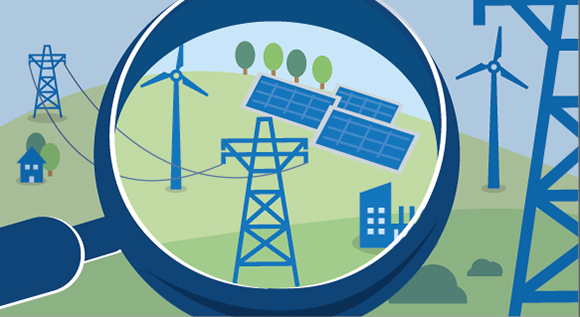What exactly is “grid congestion”?
Grid congestion occurs when a grid overload prevents electricity from reaching the consumer. But why does this happen? And, even more importantly? How can it be resolved? You’ll find the answer here.
 © BMWi
© BMWi
This is what it’s all about: because of the energy transition, much of the electricity we use has to be transported over long distances. Progress on grid expansion, however, is slow, which means that the grid is often stretched to the limits. Grid congestion (a bottleneck in the grid) is the result of this.
If you pour a small amount of water into a funnel, the exact same amount runs through it almost immediately. But if you pour in a large amount of water, the amount running out at the lower end is limited to how much fits through this small end. That’s not a problem if you have to wait for the remainder to flow through. But as soon as there is someone urgently awaiting the water, there is a problem.
When the electricity grid is like a funnel
The electricity grid is, of course, much more complicated than a funnel, but the problem is very similar. During the cold season, the wind-powered installations in north Germany, for instance, generate large amounts of electricity. This electricity is exactly what the industrial centres in the south of Germany need – especially when there is little daylight, meaning that the PV installations common in that region cannot generate much electricity. The transmission lines between north and south Germany, however, so far lack the capacity to allow for all of this electricity to be taken from one end of the country to the other.
Bottlenecks can be caused by renewables, but also by conventional power plants. And they occur not only in transmission lines, but also in small regional distribution grids. What happens in all of these cases is similar to what happens in a funnel. No matter how much you pour in on the upper end, only a small amount will flow out of the other. But there is a major difference. A funnel doesn’t care if you pour in a lot. The electricity grid does. An overload can damage the grid and even cause blackouts. This is because the grid is only stable if the amount of power that is fed into the grid matches the amount that is taken off. This is why the four German transmission systems operators (TSOs) are under a legal obligation to intervene before a bottleneck occurs, so that Germany can rely on a secure and stable supply of electricity.
Two types of action to serve one goal: a secure supply of electricity for all
The most important tool that is available to TSOs to prevent grid congestion is redispatch. This involves power plants situated in front of the emerging bottleneck being shut down. Parallel to this, power installations situated behind the bottleneck are powered up to cover the higher need for electricity.
For this to work, power plant operators need to make certain amounts of capacity available for redispatch. By the same token, TSOs lease a certain amount of capacity to be used in unusual circumstances. This is called the grid reserve.
Whilst the system is working reliably, it does come at an additional cost. The companies operating the reserve are reimbursed for this and in the event that the reserve is actually used. The overall cost was €505 million in 2016. These costs are added to the grid charge and paid by electricity consumers.
The second tool TSOs can use is feed-in management. When a bottleneck prevents electricity from reaching consumers, TSOs are free to temporarily disconnect renewables and CHP installations from the grid, even though these have priority access to the grid. In most cases, this will affect wind farms. They accounted for more than 90% of the cases in which feed-in management resulted in renewables installations being disconnected from the grid in 2016. The operators of these installations also have a right to compensation, which is also financed by consumers via the grid charge. In 2016, these costs amounted to €373 million.
However, renewables installations that have been turned off are not entitled to remuneration under the Renewable Energy Sources Act (EEG). This means that the cost for feed-in management does not accrue in addition to EEG charges, but instead of these. Just like with redispatch, power plants situated behind the bottleneck are powered up to make up for the electricity that would otherwise have been generated by the renewables or CHP installations that have been switched off.
High-performance electricity highways will be the solution
Both redispatch and feed-in management are just makeshift solutions to the problem, which can only be resolved by progress on grid expansion. The new high-performance electricity highways from north to south Germany that are already being planned will help prevent most bottlenecks in the future.
But even then, they won’t be entirely impossible. And that’s for a reason. Economically speaking, it would make no sense to upgrade Germany’s entire grid system until it is able to handle the maximum amount of electricity that can be traded. This would be too expensive and also inefficient, given that these peaks only happen a few times per year and only for a few hours. This is why it will still be necessary for the TSO to intervene whenever a bottleneck is impending. But this will happen much less frequently and at a much lower cost than today. And it will be a better solution than having our electricity system vamped up to the maximum.

